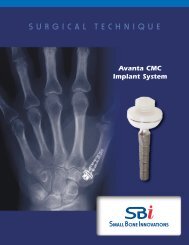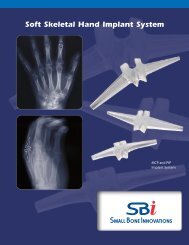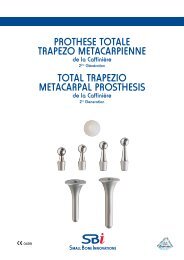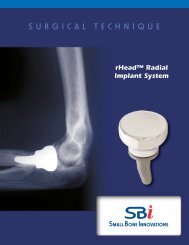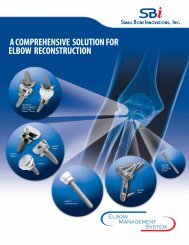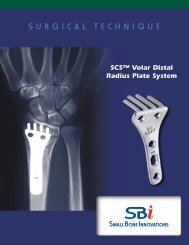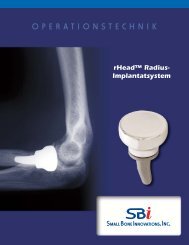PGT INSTRUmENTATIoN - Small Bone Innovations
PGT INSTRUmENTATIoN - Small Bone Innovations
PGT INSTRUmENTATIoN - Small Bone Innovations
You also want an ePaper? Increase the reach of your titles
YUMPU automatically turns print PDFs into web optimized ePapers that Google loves.
Medial/Lateral Cut Guide<br />
Additional pin fixation holes if necessary<br />
Next, the M/L talar cut guide (FIGURE 27) is secured to the datum<br />
using the locking bolt. Using the reciprocating saw with the depth<br />
marking (FIGURE 28), the medial and lateral edges of the talus are<br />
cut.<br />
The saw blade is advanced only to the depth indicated by the<br />
marking on the saw blade to minimize risk of soft tissue damage.<br />
(FIGURE 29) Ideally 2 to 3 mm of bone is removed from the medial<br />
and lateral sides of the talus. The cuts should penetrate distally<br />
about 10 mm on the medial side, and about 17 mm on the lateral<br />
side. The blade is rotated until the top edge of the saw blade lines<br />
up with the line on the M/L talar cut guide. (FIGURES 30a+b) The<br />
blade is advanced anteriorly to complete the cut.<br />
Be cautious not to “lever” the blade too firmly against the<br />
guide and risk loosening of the fixation pins. Additional pin<br />
fixation holes may be used for extra stability if necessary.<br />
M/L Cut Guide<br />
Figure 27<br />
Saw Blade with Depth Marking<br />
Figure 28<br />
Move anterior<br />
to complete cut<br />
Figure 29<br />
Figure 30a<br />
Figure 30b<br />
12<br />
S.T.A.R. ® Scandinavian Total Ankle Replacement Surgical Technique



